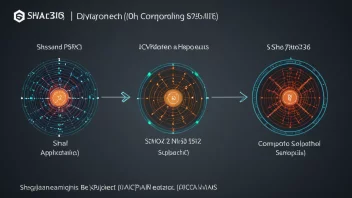Urban resilience is a critical concept that focuses on the ability of cities to absorb, recover from, and adapt to adverse events such as natural disasters, economic shocks, and social disruptions. In an era defined by rapid urbanization and increasing vulnerability to such challenges, the role of technology—particularly cloud computing—has become indispensable. This article delves deep into how cloud computing enhances urban resilience, exploring its applications in data management, emergency response, and infrastructure development, along with case studies that illustrate these concepts in action.
Understanding Urban Resilience
Before delving into the role of cloud computing, it is essential to understand what urban resilience entails. Urban resilience encompasses a city’s capacity to withstand and recover from disruptions while maintaining essential functions. It includes various dimensions, such as environmental sustainability, economic stability, social equity, and robust governance.
Key Components of Urban Resilience
- Environmental Resilience: The capacity to manage and mitigate environmental risks, such as climate change and natural disasters.
- Economic Resilience: The ability of an urban economy to withstand shocks and sustain growth.
- Social Resilience: The strength of community ties and social networks that facilitate mutual support during crises.
- Institutional Resilience: The capability of governance structures to adapt and respond effectively to challenges.
Cloud Computing: An Overview
Cloud computing refers to the delivery of computing services—including servers, storage, databases, networking, software, and analytics—over the Internet (“the cloud”). This model offers several advantages, such as scalability, flexibility, and cost-effectiveness, making it an attractive option for urban planners and local governments.
Core Characteristics of Cloud Computing
- On-Demand Self-Service: Users can provision computing capabilities as needed automatically without requiring human interaction.
- Broad Network Access: Services are accessible over the network through various devices.
- Resource Pooling: Multiple users share the same resources dynamically, allowing for efficient utilization.
- Rapid Elasticity: Capabilities can be scaled up or down quickly based on demand.
- Measured Service: Cloud systems automatically control and optimize resource use by leveraging a metering capability.
The Intersection of Cloud Computing and Urban Resilience
Cloud computing plays a pivotal role in enhancing urban resilience by facilitating data-driven decision-making, improving communication during emergencies, and enabling the management of urban infrastructure.
Data-Driven Decision Making
Access to real-time data is crucial for city managers and planners. Cloud computing provides the infrastructure necessary to collect, store, and analyze vast amounts of data from various sources, including sensors, social media, and public databases. By harnessing this data, cities can gain insights into traffic patterns, pollution levels, and social dynamics, enabling informed decision-making.
Case Study: Smart City Initiatives
Many cities globally are adopting smart city initiatives that leverage cloud computing to improve urban management. For example, Barcelona has implemented a cloud-based platform that integrates data from various city services, allowing for better resource management and enhanced citizen engagement. This platform has improved waste collection, energy management, and traffic flow, contributing to the city's resilience.
Emergency Response and Management
In times of crisis, effective communication and coordination are vital. Cloud computing facilitates emergency response by providing a centralized platform for information sharing among various agencies, including police, fire, and medical services. This integration ensures that responders have access to real-time information, improving their ability to react swiftly and effectively.
Case Study: Disaster Response in New Orleans
After Hurricane Katrina, New Orleans embraced cloud computing to enhance its disaster response capabilities. The city implemented a cloud-based emergency management system that allows first responders to access real-time data on flooding, traffic conditions, and resource availability. This system has significantly improved coordination and response times during subsequent emergencies.
Infrastructure Management
Urban infrastructure is often under strain due to increasing populations and environmental stresses. Cloud computing provides tools for monitoring and managing infrastructure systems, such as transportation networks, utilities, and public services. By utilizing Internet of Things (IoT) devices and cloud services, cities can optimize maintenance schedules and resource allocation.
Case Study: Infrastructure Management in Singapore
Singapore has implemented an integrated cloud platform for infrastructure management that collects data from sensors embedded in roads, bridges, and public utilities. This system allows city officials to monitor the condition of infrastructure in real-time, predict maintenance needs, and allocate resources efficiently, ultimately enhancing the city's resilience against infrastructural failures.
Challenges and Considerations
While the benefits of cloud computing in enhancing urban resilience are significant, several challenges must be addressed:
Data Security and Privacy
With the increasing reliance on cloud services, concerns regarding data security and privacy are paramount. Cities must implement robust cybersecurity measures to protect sensitive information and ensure compliance with regulations.
Digital Divide
The digital divide remains a critical issue, as not all urban residents have equal access to technology and the internet. Policymakers must address these disparities to ensure that the benefits of cloud computing are equitably distributed.
Interoperability
Urban systems often involve multiple stakeholders with different technologies and platforms. Achieving interoperability among these systems is essential for effective integration and data sharing.
Future Trends in Cloud Computing and Urban Resilience
The future of urban resilience is closely tied to advancements in cloud computing technology. Some emerging trends include:
Artificial Intelligence and Machine Learning
Integrating AI and machine learning into cloud platforms can enhance predictive analytics, enabling cities to anticipate and mitigate risks more effectively.
Sustainable Cloud Solutions
As urban areas face growing environmental challenges, sustainable cloud solutions that prioritize energy efficiency and reduced carbon footprints will become increasingly important.
Community Engagement
Cloud platforms that facilitate community engagement and participation in urban planning will empower citizens to contribute to resilience strategies actively.
Conclusion
In conclusion, cloud computing is transforming the landscape of urban resilience by providing the tools and infrastructure necessary for data-driven decision-making, effective emergency response, and efficient infrastructure management. As cities continue to face complex challenges, the integration of cloud technology will be crucial in fostering resilience and adaptability. However, addressing challenges such as data security, equity, and interoperability will be vital in realizing the full potential of cloud computing in enhancing urban resilience.






